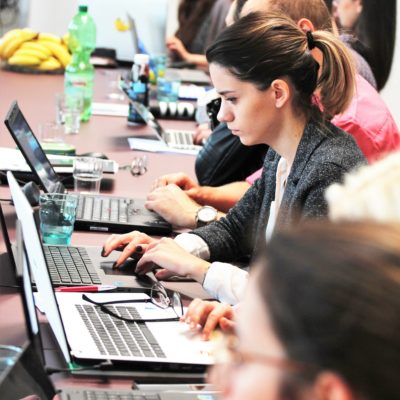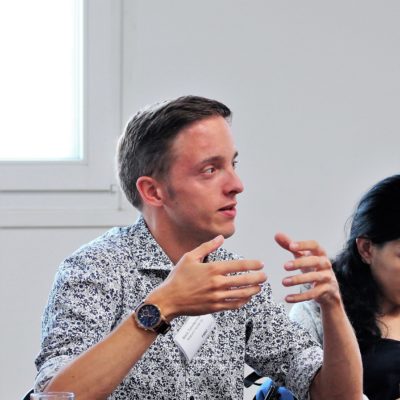By Mariell Raisma
The most influential media outlets from public broadcasting in Germany are ARD (ard.de) and ZDF (zdf.de). “These are channels where most Germans considers them to be the most influential, informative, up to date and the most fact-based channels,” Julia Brötz from Alex Berlin says.
Access to information as a basic necessity
According to her, on the one hand, Germans trust them the most, and on the other side, the quality standards are the highest. They are also known, and they have their reporters all over the world to cover German but also international events. “These two media outlets are especially there in public broadcasting system to give access to information which is seen as a basic necessity in Germany, in the best possible way,” she says.
There are two news programmes. Firstly, Tagesshau (tagesschau.de) which is at 20.00 every day. So 20.00-20.15 is the time slot when most German citizens are in front of the television to watch Tagesschau. All television programming in Germany regardless of whether it is a private or public channel is modelled around when the Tagesshau is shown.
ZDF has Heute Journal (zdf.de/nachrichten/heute-journal) which is an equivalent for ARD’s Tagesshau, which is also very trusted. ZDF is also very known by their documentaries and political comedies. “I personally love Heuteshow, where they make fun over news programming. It is very popular. They make fun of themselves,” Brötz says. There are totally different journalists, and they are separately funded as Heute Journal. “I like ZDF because it is a little bit more young and modern than ARD.”
The most prominent politicians give to ARD and ZDF their interview first. “So you cannot say that one of them has a monopoly, we have two public broadcasters, they kind of balance each other,” Brötz explains.
Bild-Zeitung (bild.de) is Germany’s largest daily newspaper founded in 1952 by Axel Springer AG. The average circulation of Bild is 2,650,548 and the readership is 15,000,000. “It is yellow press, so there is a lot of campaigning, populism. What I find quite funny, is that there are blogs that check the facts in Bild Zeitung to make sure whether it is fake news or campaigning. I like this about German media system that there is something that checks whether it is serious journalism, is it doing what it has to do, adding the facts which are missing,” she says.
Süddeutsche Zeitung (sueddeutsche.de) has a regional aspect, but it is read all over Germany. It is one of the serious and more neutral newspapers that most people in Germany trust,” Brötz says.
“Der Spiegel is a newspaper which I read for two hours a day,” she says. It is a physical magazine which has a very long history in Germany. It is mostly investigative journalism, politics and news. They also have a completely separate, online product, has the same name – Spiegel Online (spiegel.de) – and it is a completely different team, and they are also economically separated from them. However, Spiegel Online is the most famous online medium which is only on an online platform.
One of the largest radio station is 1LIVE (www1.wdr.de/radio/1live/) which has a combination of contemporary music, humour and culture.
Julia Brötz’s personal TOP 5
“I read news from Spiegel Online (spiegel.de),” Brötz says.
Arte (arte.tv/de/) is also public broadcasting, but it is cooperation between France and Germany, so it has been around for a long time.
“I love Arte because they have a lot of foreign language programming and it is very alternative programming, not mainstream, but so professionally produced, that it is beautiful and a lot of people watch this,” she explains. So it is very well-known, but it focuses on the things which would not normally be produced in the for-profit market. They have a lot of platforms like Arte Creators where they have open participation. There are subtitles.
“Here in Germany the foreign language programming is subtitled in German, and in France, it is in French,” she says. All of this programming is produced in both: in German and French, for both markets. It public broadcasting but it is produced in a very modern and very innovative way for a young audience. It is very multicultural, and minority voices are being heard. Arte is also supporting a lot of films which are done in Germany.
The ARD/ZDF has a content network called Funk, to which Deutschland3000 (facebook.com/Deutschland3000/) belongs. Deutschland3000 is one of the formats. Funk produces publicly funded content online only, which is shown just in social media platforms, an app and an online website to reach a young audience because they don’t consume traditional media anymore. Deutschland 3000 is politics for young people, just online, on Facebook.
Jäger & Sammler (facebook.com/JaegerundSammlerDE/), which is investigative journalism for young people in Facebook.
“There are also several Youtube formats, like Y-Kollektiv (https://www.youtube.com/channel/UCLoWcRy-ZjA-Erh0p_VDLjQ), which similarly to Deutschland 3000 reach up to 4 million people which is absolutely comparable with everything that is going on in traditional media,” she says. But it is produced for young people, by young people on the internet. “It is a different type of produce, and the most important thing is the community discussions – interacting with the community. Really being in touch with your community and what their topics are and their voices and including them.”




